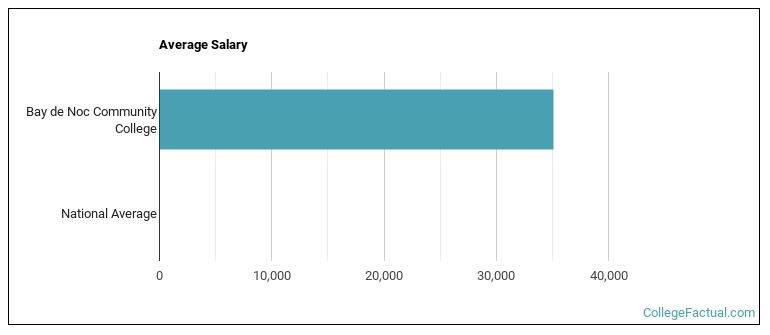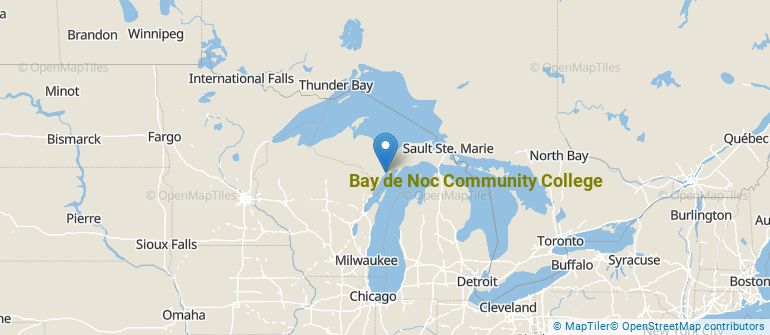 by our College Data Analytics Team
by our College Data Analytics TeamExplore the best ranked schools for the programs you are most interested in.
According to College Factual's 2025 analysis, Bay College is ranked #1,775 out of 2,152 schools in the nation that were analyzed for overall quality. This is an improvement over the previous year, when Bay College held the #1,804 spot on the Best Overall Colleges list.
Out of the 56 colleges in Michigan, Bay College is ranked at #47.
Since Bay de Noc Community College has an open admissions policy, being accepted to the school isn't that hard. However, a full basic things - such as a high school diploma or equivalent - may be required. Also, go over your application to make sure it is complete before you submit it.
With a student to faculty ratio of 17 to 1, Bay de Noc Community College is about average in this regard as the nationwide rate is 15 to 1. While this does not translate directly to class size, it's a good indicator of how much time professors will have to spend with their students on a one-on-one basis.
When estimating how much access students will have to their teachers, some people like to look at what percentage of faculty members are full time. This is because part-time teachers may not have as much time to spend on campus as their full-time counterparts.
The full-time faculty percentage at Bay de Noc Community College is 100%. This is higher than the national average of 47%.
The freshmen retention rate is a sign of how many full-time students like a college or university well enough to come back for their sophomore year. At Bay de Noc Community College this rate is 58%, which is a bit lower than the national average of 68%.
During the 2017-2018 academic year, there were 1,898 undergraduates at Bay College with 725 being full-time and 1,173 being part-time.
| $0-30 K | $30K-48K | $48-75 | $75-110K | $110K + |
|---|---|---|---|---|
| $7,818 | $8,941 | $10,610 | $12,139 | $13,527 |
The net price is calculated by adding tuition, room, board and other costs and subtracting financial aid.Note that the net price is typically less than the published for a school. For more information on the sticker price of Bay College, see our tuition and fees and room and board pages.
While almost two-thirds of students nationwide take out loans to pay for college, the percentage may be quite different for the school you plan on attending. At Bay College, approximately 28% of students took out student loans averaging $5,475 a year. That adds up to $21,900 over four years for those students.
Get more details about paying for Bay de Noc Community College.

See which majors at Bay de Noc Community College make the most money.
Get more details about the location of Bay de Noc Community College.

Contact details for Bay College are given below.
| Contact Details | |
|---|---|
| Address: | 2001 N Lincoln Road, Escanaba, MI 49829-2511 |
| Phone: | 906-786-5802 |
| Website: | https://www.baycollege.edu/ |
| Most Popular Majors | Bachelor’s Degrees | Average Salary of Graduates |
|---|---|---|
| Liberal Arts General Studies | 83 | NA |
| Nursing | 50 | NA |
| Criminal Justice & Corrections | 22 | NA |
| Business Administration & Management | 20 | NA |
| Computer Engineering Technology | 18 | NA |
| Allied Health Professions | 18 | NA |
| Precision Metal Working | 11 | NA |
| Allied Health & Medical Assisting Services | 8 | NA |
| Vehicle Maintenance & Repair | 8 | NA |
| Accounting | 7 | NA |
Online courses area a great option for busy, working students as well as for those who have scheduling conflicts and want to study on their own time. As time goes by, expect to see more and more online learning options become available.
In 2022-2023, 1,366 students took at least one online class at Bay de Noc Community College. This is an increase from the 1,317 students who took online classes the previous year.
| Year | Took at Least One Online Class | Took All Classes Online |
|---|---|---|
| 2022-2023 | 1,366 | 812 |
| 2021-2022 | 1,317 | 713 |
| 2020-2021 | 1,244 | 562 |
| 2018-2019 | 1,054 | 437 |
Learn more about online learning at Bay de Noc Community College.
Footnotes
*The racial-ethnic minorities count is calculated by taking the total number of students and subtracting white students, international students, and students whose race/ethnicity was unknown. This number is then divided by the total number of students at the school to obtain the racial-ethnic minorities percentage.
References
More about our data sources and methodologies.